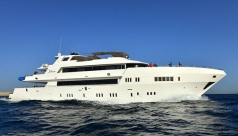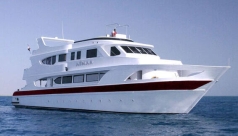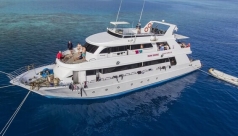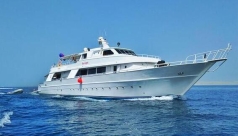The Northern Red Sea
Diving in Egypt as a whole is a pretty special attraction and like a box of Quality Street - everybody has their own favourite. Some would say that Sharm El Sheikh on the Sinai Peninsula has the best of what Red Sea scuba diving has to offer. The legendary dive location that is Ras Mohammed, wrecks the likes of the Thistlegorm and the Straits of Tiran are all easily accessible from Sharm El Sheikh. Dotted with at least 10 other interesting wreck sites, the area is also alive with big fish such as barracuda, turtles and eagle rays.
Sharm El Sheikh is located on the historic Sinai peninsula in the far north of the Red Sea. The town itself is among the best places on the Egyptian coastline for variety of restaurants, hotels and nightlife. It is popular among people doing dive courses since there are many nearby sites suitable for instructional dives. It is also a very popular spot for certified divers doing daytrips or boarding one of the liveaboards that depart from here. Daytrips from Sharm can reach sites as diverse as Ras Mohammed, the Straits of Tiran,
the wreck of the Dunraven and of course, the famous SS Thistlegorm. The liveaboards operating in the northern Red Sea visit all of these sites and more.
Ras Mohammed is the site of the first national park in Egypt. Its location is at the confluence of waters from the Gulf of Suez and the Gulf of Aqaba. This mix results in a wide range of diversity in terms of coral and fish life. Its best known dive sites include
Shark Reef and
Yolanda Reef, 2 peaks rising up from the depths and home to grey reef sharks, tuna, barracuda, snapper and even hammerhead sharks. As you poke around looking for sting rays, moray eels and scorpionfish around Yolanda Reef, you can indulge in some unexpected lavatorial humour! As you fin over the sloping reef, strewn over the sea-bed beneath you are dozens of toilets and other bathroom accessories which were the cargo of the sunken Yolanda wreck.
The SS Thistlegorm wreck is possibly the most famous site in all of Egypt diving, and with good reason. It is a memorable sight to see WWII motorcycles and jeeps still in the same position they were when this ship went down. They are now heavily encrusted and are part of the ocean floor. What an amazing glimpse into history this dive is! It is a very popular site and is best dived early in the morning from a liveaboard, before the daytrip boats arrive. The Thistlegorm is king among the many great wrecks in the northern Red Sea.
Straits of Tiran is a reef system adored by divers who are keen to experience deep walls and reef flats teeming with schools of fish. Shark lovers are drawn here by the promise of encounters with hammerhead sharks and possibly even tiger sharks. The 4 reefs that comprise this system are Woodhouse, Thomas, Gordon and Jackson reefs.
Hurghada is at the centre of the Red Sea diving world. While courses and daytrips are both conducted from Hurghada, it is unarguably the main port for Egypt liveaboards. From this location boats can either travel north to do northerly routes (including many famous wrecks) or south to do southerly routes, or a combination of the 2! Local sites reachable by daytrip include
Giftun Island and further to
the Abu Nuhas wrecks and
Salem Express, offering a good variety of experiences. You might even encounter dolphins at local sites near Hurghada.
Abu Nuhas a.k.a. the Shaab Abu Nuhas Reef is a shallow reef that has caused the sinking of more boats than anywhere else in the Red Sea. There are currently 5 wrecked cargo ships lying off its northerly slopes. Most of them, including the
Giannis D, the
Chrisoula K and the
Kimon K met their watery fate in the 1970s or 80s. However, the oldest of them is the
Carnatic which sank en route to India in September 1869. Its cargo of gold, wine and cotton went down with it, although sadly none is left these days. What is left of the frame of this boat is now completely part of the marine world and covered in soft corals, encrusting sponges and hydroids.
The Southern Red Sea
For jaded divers who have seen it all, the further south you go in the Red Sea, the higher the quality of the diving. Hurghada and
Marsa Alam offer you a starting point from which to explore the incredibly rich sites and pelagic shark action at The Brothers, Daedalus Reef and St. John's which satisfy even the most experienced scuba divers. These areas in the south of Egypt are your best bet for encounters with oceanic whitetip sharks and large schools of fish. They are also home to interesting caves and have many tunnels to explore.
The Brothers Islands are a central feature of diving in the southern Red Sea. For many regular visitors, no Egypt diving vacation is complete without a liveaboard trip that includes these famous twin islands. They are easily identifiable by the sight of a Victorian-era lighthouse rising up from the larger of the 2 islands. Numerous memorable dive sites surround these islands, including 2 wrecks: the
Numidia and
Aida. The Brothers are among the best sites for diving with sharks. Most frequently sighted species include whitetips, silvertips, grey reef sharks, hammerheads and even oceanic whitetips and thresher sharks.
Daedalus Reef is another of the most visited sites of the south. Sometimes the steep walls of Daedalus are flushed with strong currents which hold the promise of predator action. Among the larger species likely to be seen here are schools of hammerheads, tuna and manta rays. Daedalus Reef is in a very remote location, over 80 km from Marsa Alam, and like many of the Red Sea's best dive sites, it is only visited by liveaboard.
Elphinstone is a site that is often mentioned in the same breath as Daedalus and both sites regularly form part of the same liveaboard itinerary. Named after a British military commander, this reef is characterised as drift diving over healthy reefs, past sheer walls and exploring little caverns. Sharks, schools of various reef fish and colourful little delights like red-toothed triggerfish and purple and orange anthias make this an colourful experience! Elphinstone is popular both for liveaboard divers, but also as a daytrip destination, given its proximity to Marsa Alam.
St. John's Reefs are found in the deep south of Egypt, not far north of the Sudanese border and are therefore considered slightly off-the-beaten-track. The dive sites here enjoy unusual topography featuring channels, caverns, overhangs and tunnels, atypical of the usual diving in the Red Sea. There are plenty of sharks and pelagics around this region too, as well as dolphins and mantas. Other creatures of note in this area include dugongs, squid, Spanish dancers, bigmouth mackerel and bumphead parrotfish.





















































